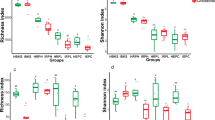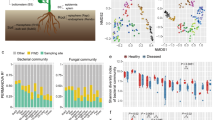Abstract
Fungicides are commonly used to manage plant pathogens. However, little is known about their effects on the non-target fungal communities that inhabit inside and outside the plant. These fungicides may have adverse effects on beneficial microbial communities with possible consequences for plant health and productivity. Hence, a metagenomic approach, based on the ITS2 region of fungal rDNA, was used to study the impact of foliar application of two fungicides (propineb and iprodione + carbendazim) on non-target tomato leaf fungal communities, in the context of early blight disease management. Metagenomic analysis revealed that the richness and diversity of tomato leaf fungal populations were adversely affected by the chemical treatments tested. Among the two fungicides, propineb (contact fungicide) imparted less non-targeted microorganisms than iprodione + carbendazim (systemic fungicide). In addition, all samples showed association of pathogenic genera Cladosporium, Corynespora, Pseudocercospora along with early blight pathogen Alternaria on tomato leaves that otherwise were undetected. Metagenomic studies also revealed a new mode of action for fungicides and bioagents besides their direct effect that is shifting the microbial community structure so that it provides greater resistance against the pathogen.



Similar content being viewed by others
References
Abdelfattah A, Wisniewski M, Nicosia O, Schena L (2016) Metagenomic analysis of fungal diversity on strawberry plants and the effect of management practices on the fungal community structure of aerial organs. PLoS ONE 11(8):e0160470
Balin P, Stapleton A (2011) Application of an antibiotic resets the maize leaf phyllosphere community and increases resistance to southern leaf blight. Acta Hortic 905:57–62
Caporaso JG, Kuczynski J, Stombaugh J, Bittinger K, Bushman FD, Costello EK, Huttley GA (2010) QIIME allows analysis of high-throughput community sequencing data. Nat Methods 7(5):335–336
Das S, Bhattacharya S (2008) Enumerating outdoor aeromycota in suburban West Bengal India with reference to respiratory allergy and meteorological factors. Ann Agric Environ Med 15(1):105–112
Denchev CM, Denchev TT (2013) Erratomycetaceae, fam. nov., and validation of some names of smut fungi recently described from India. Mycobiota 1:63–70
Edgar RC (2010) Search and clustering orders of magnitude faster than BLAST. Bioinformatics 26(19):2460–2461
FAO (2011) Bulletin of Statistics. Food and Agricultural Organization of the United Nations 2:85
Hofmann T, Kirschner R, Piepenbring M (2010) Phylogenetic relationships and new records of Asterinaceae (Dothideomycetes) from Panama. Fungal Divers 43:39–53
Karlsson I, Friberg H, Steinberg C, Persson P (2014) Fungicide effects on fungal community composition in the wheat phyllosphere. PLoS ONE 9(11):e111786
Knief C, Delmotte N, Chaffron S, Stark M, Innerebner G, Wassmann R, von-Mering C, Vorholt JA, (2012) Metaproteogenomic analysis of microbial communities in the phyllosphere and rhizosphere of rice. ISME J 6:1378–1390
Leye D (2013) The life cycle of the smut fungus Moesziomyces penicillariae is adapted to the short-cycle of the host Pennisetum glaucum. Fungal Biol 117:311–318
Luo L, Zhang Z, Wang P, Han Y (2019) Variations in phyllosphere microbial community along with the development of angular leaf spot of cucumber. AMB Expr 9:76–89
Minot SS, Krumm N, Greenfield NB (2015) One Codex: a sensitive and accurate data platform for genomic microbial identification. bioRxiv 12:21–32
Muller MEH, Urban K, Köppen R, Siegel D, Korn U, Koch M (2015) Mycotoxins as antagonistic or supporting agents in the interaction between phytopathogenic Fusarium and Alternaria fungi. World Mycotoxin J 8:311–321
Perazzolli M, Antonielli L, Storari M, Puopolo G, Pancher M, Giovannini O (2014) Resilience of the natural phyllosphere microbiota of the grapevine to chemical and biological pesticides. Appl Environ Microbiol 80:3585–3596
Pinto C, Pinho D, Sousa S, Pinheiro M, Egas C, Gomes AC (2014) Unravelling the diversity of grapevine microbiome. PLoS ONE 9:e85622
Sab V, Milles J, Krämer J, Prange A (2012) Competitive interactions of Fusarium graminearum and Alternaria alternata in vitro in relation to deoxynivalenol and zearalenone production. J Food Agric Environ 5:257–261
Sahu DK, Khare CP, Singh P, Thakur MP (2013) Evaluation of newer fungicide for management of early blight of tomato in Chhattisgarh. Bioscan 8(4):1255–1259
Singh S, Gupta R, Kumari M, Sharma S (2015) Non target effects of chemical pesticides and biological pesticide on rhizospheric microbial community structure and function in Vigna radiata. Environ Sci Pollut Res 12:1–11
Tej M, Singh D, Kumar A, Sangeeta S (2013) Status of susceptible host for foliicolous fungi from North Terai forests of Uttar Pradesh India. New Phytol 220:69–81
Toju H, Okayasu K, Notaguchi M (2019) Leaf-associated microbiomes of grafted tomato plants. Sci Rep 9:17–87
Tsurumaru H, Okubo T, Okazaki K, Hashimoto M, Kakizaki K (2015) Metagenomic analysis of the bacterial community associated with the tap root of sugar beet. Microbes Environ 30(1):63–69
Tuite J (1969) Plant pathological methods-fungi and bacteria. Burgess Publ Co, Minneapolis, Minnesota, p 239
Acknowledgements
The authors thank Kerala Agricultural University, College of Agriculture, Vellanikkara, Thrissur, Kerala, India for providing the infrastructure and technical facilities.
Author information
Authors and Affiliations
Contributions
V. Sumbula and P. Sainamole Kurian conceived of or designed study. V. Sumbula performed research. V. Sumbula, D. Girija, and K. Anita Cherian analyzed data. V. Sumbula and P. Sainamole Kurian wrote the paper. As corresponding author, I confirm that the manuscript has been read and approved for submission by all the named authors.
Corresponding author
Ethics declarations
Competing interests
The authors declare no competing interests.
Additional information
Publisher's Note
Springer Nature remains neutral with regard to jurisdictional claims in published maps and institutional affiliations.
Supplementary Information
Below is the link to the electronic supplementary material.
Rights and permissions
About this article
Cite this article
Sumbula, V., Kurian, P.S., Girija, D. et al. Impact of foliar application of fungicides on tomato leaf fungal community structure revealed by metagenomic analysis. Folia Microbiol 67, 103–108 (2022). https://doi.org/10.1007/s12223-021-00920-x
Received:
Accepted:
Published:
Issue Date:
DOI: https://doi.org/10.1007/s12223-021-00920-x




